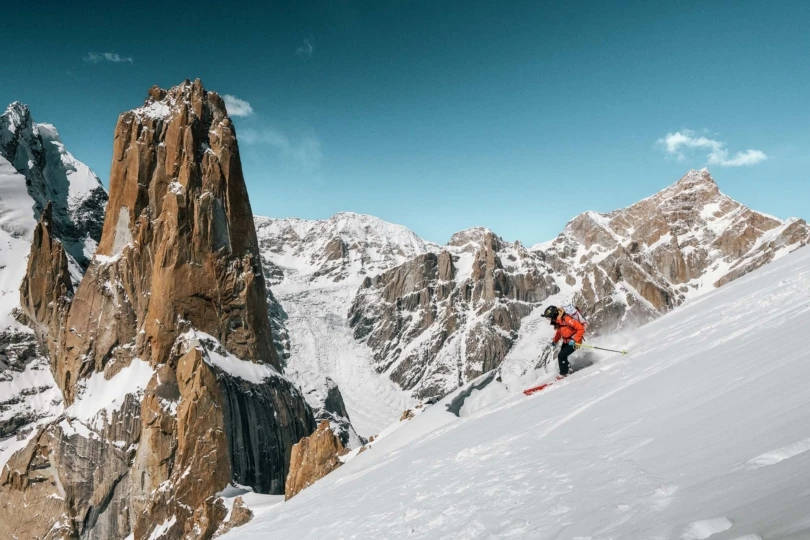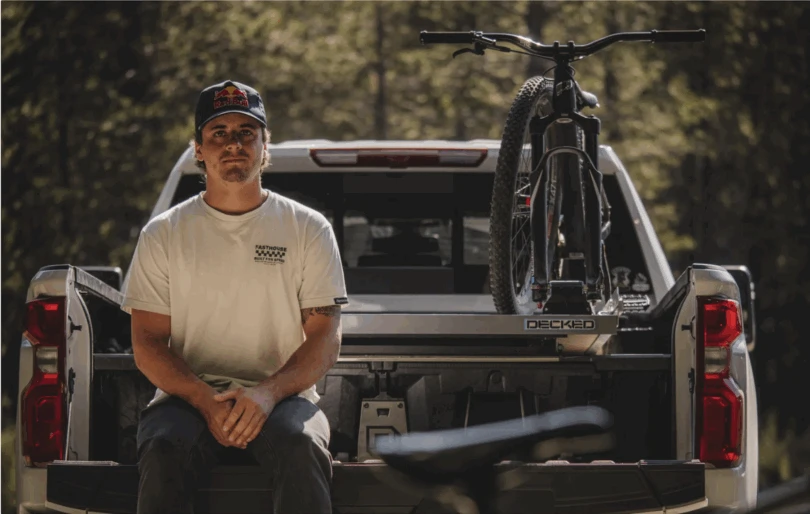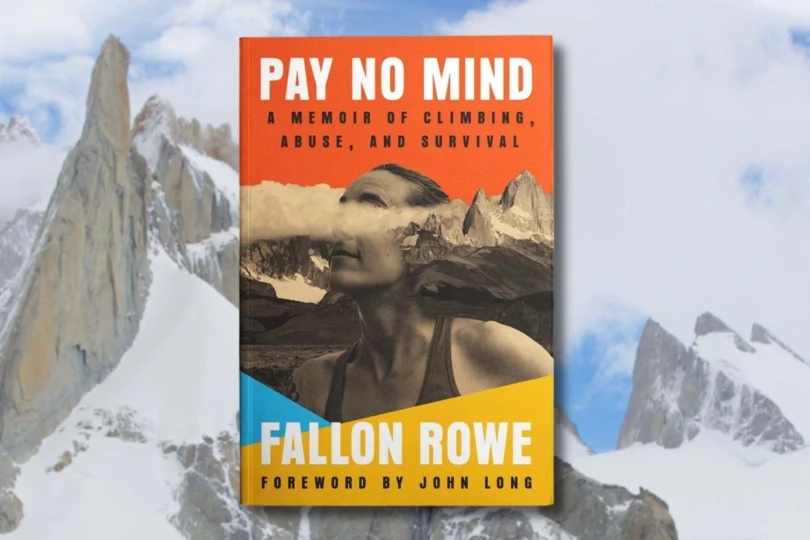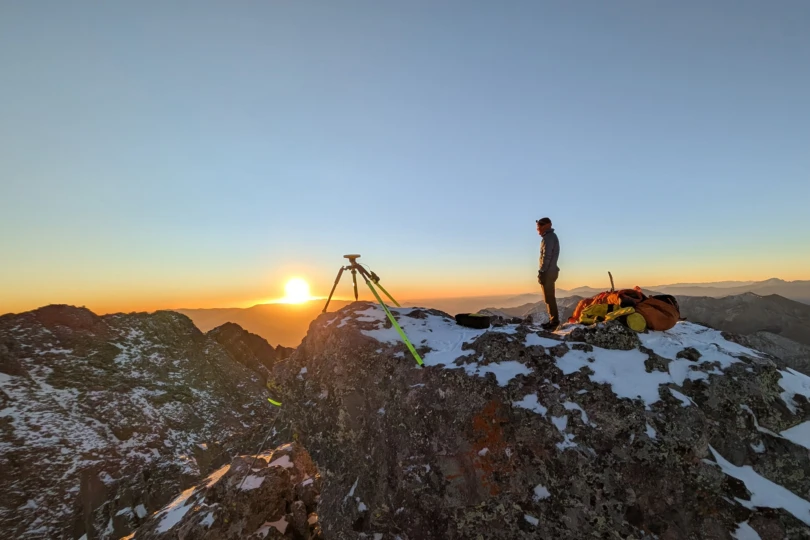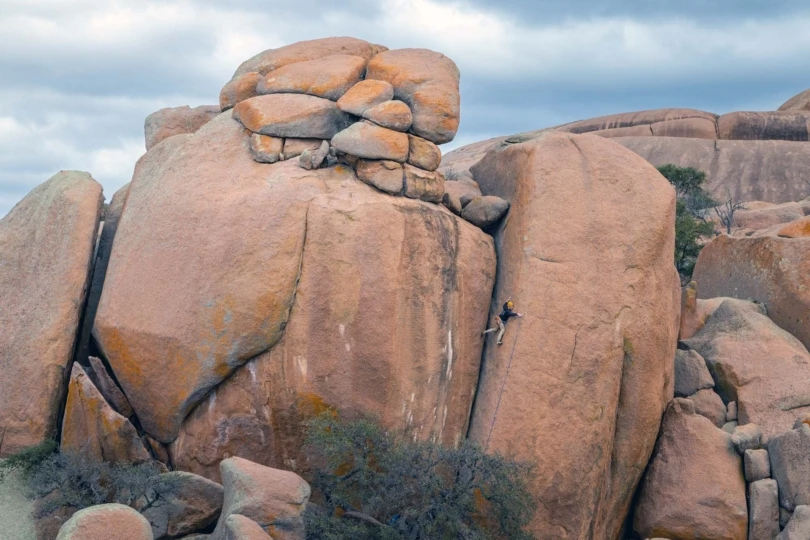The Tetons (especially the Grand Teton) are so striking they seemingly beg to be climbed. A few GearJunkie staff climbed it last summer. Read on for a recap of the journey, planning and training tips, and our packing list.
The jagged and majestic Teton Range near Jackson, Wyoming, is an important part of American climbing. Topping out at 13,775 feet, the Grand Teton is the highest peak in the range, and it draws climbers from around the world.
The first recorded summit of the Grand was in 1898 by Billy Owen, Rev. Franklin Spalding, and ranch hands John Shive and Frank Peterson. Since then, it has been climbed by luminaries like Yvon Chinourd and Jimmy Chin, as well as everyday folks like me and my friends.
On a recent trip, two of my compatriots and I — only one of whom was a legit mountaineer — set out to tackle the Grand. For two of us, this trip marked a perfect intro to alpine climbing. And looking back, I can say it was the absolute best adventure of our lives (to date).
There’s a lot to gain from a climb like this. So we’re here to share what we learned on the mountain as well as important information on planning, training, and what to pack for your Grand Teton climb.

Guide to Climbing the Grand Teton
Preparation, Planning, and Training
There are a few key decisions you need to make for your climb.
- What time of year do you plan to climb?
- Are you camping or doing it in a single day?
- Who is/are your climbing partner(s)?
- What route do you plan to climb?
- What will you do to train and prepare?
- Do you need to splurge on any fancy new gear for the climb? (See our suggestions and packing list at the bottom of this article.)
What Month Is Best to Climb the Grand Teton?
Late July through mid-September is the most popular time to climb because there’s less chance of encountering snow and ice on the route. You can climb any time of year, but know you’ll likely run into snow and will need appropriate gear and skills.
An “icy 5.4” is no longer a 5.4. We climbed on August 4-6 and saw no snow on the route. Conditions vary each year, so check with the ranger station on conditions before you go.
Grand Teton Camping Permits
If you plan to camp overnight in Garnet Canyon, you’ll need a permit. We chose to camp because we wanted to spend more time in the mountains, and doing it in 2 days is less strenuous — at least in theory. But you do have to carry camping gear and deal with permits.

If you know your climbing dates, you can reserve permits ahead of time from early January through mid-May from Grand Teton National Park. If you don’t have a set date, you can get walk-up permits on the day of or before your climb. Know that camping permits are very limited, and you’re not guaranteed to get your ideal camping zone or a permit at all.
We arrived at the Jenny Lake Ranger Station at 6:30 a.m. to wait in line for permits the day before we climbed. There were three other climbing parties ahead of us, and we got the last permit for the Lower Saddle. We were stoked! Most people like to camp higher on the mountain to shorten the distance of their climbing day. Permit availability will dictate where you camp, so go into it with a flexible attitude.
How to Choose a Climbing Partner
You may already have a climbing partner, but if you don’t, pick someone you like who is adventurous, will suffer with you, and has solid climbing experience. Be sure your partner will commit to showing up in shape as well.

Which Route to Climb
There are several routes up the Grand Teton. Here, we detail three of the top climbs.
The Owen Spalding is the easiest and most popular by far. It has three pitches of 5.4 climbing. Many guided climbers and first-time Teton climbers choose the Owen Spalding (sometimes called the OS). In high season, there can be mini “traffic jams” near some of the climbing sections. It’s a spectacular climb. But know that if you climb in August, you will see others on the route and may have to wait a bit.
The Exum Ridge is iconic and has two sections. The lower is six pitches of 5.4-5.7 climbing, and the Upper is six-plus pitches of 5.4 depending on how often you rope up. We climbed the lower in complete amazement, and for us, it was harder than we expected. There are ways to combine the Owen Spalding with the Exum Ridge; Wyoming Whiskey proved to be the best online resource for info and photos of the Owen Spalding and Upper Exum routes.
The Petzold Ridge is also a classic six-pitch climb with a 5.6 rating. This stellar-looking climb sees less traffic than the OS, which appeals to some climbing parties. Of note, it has an amazing Window Pitch (see photo below).

Training to Climb the Grand Teton
Training is the most time-consuming part of the process. You need to respect the mountain and prepare properly. Depending on your experience, this could be the hardest thing you’ve ever done or it might be your Sunday run. Either way, being physically and mentally prepared is key.
This was my first foray into mountaineering, and as I live in Minnesota at only 970 feet above sea level, I knew I’d need to start training early. Starting in January 2020, I followed phases 1 and 2 of this training program, doing home workouts with weights and a ton of cardio on a NordicTrack X22i incline trainer.
For me, phase 3 involved a lot of steep hiking in Wyoming (6,700 feet and up) during June and July to prepare for our August climb. The other members of my climbing party, Alex Hansen and Zach Burton, also came into the climb with a very high level of fitness, and Alex brought the bulk of our mountaineering experience.
Trip Recap: Climbing the Grand Teton
Like any Jackson adventure, this one started with a breakfast burrito from D.O.G. We parked at the Lupine Meadows trailhead and headed up the mountain. Overall, it’s about 8 miles in and 5,000 feet up to the Lower Saddle. The scenery of Garnet Canyon is unreal. There are spots to fill up water throughout the canyon, and the cold glacial runoff was perfect in the August heat.
To keep moving, we hiked for an hour and rested for 10 minutes until we reached our destination. There’s a short section of rock just below the Lower Saddle with fixed ropes and easy climbing.
Once at the Lower Saddle, we chose one of the obvious campsites. There were five to seven good sites next to the largest rocks to help block the wind. We scoped out the path to the Lower Exum, ate, hydrated, packed for the next day, and tried to get to bed early.
Climbing the Lower Exum Ridge
The stoke was high as we departed camp at dawn. We followed the guide book’s info and beta from rangers to find the start of the climb. Once on route, the climbing was world-class.

It works up a striking ridge with magnificent views. The exposure increases the higher you climb, adding to the adrenaline and wow factor of the climb. The fourth and fifth pitches are engaging, challenging, or downright hard depending on your skill and energy level. If an amazing day of climbing was the goal, we 10x’ed it. But, the goal was the summit, and we were far from it.
We chose the Lower Exum knowing that we could bail at a ledge called Wall Street if needed. As a party of three, we climbed too slowly at altitude (12,000-plus feet). Slow transitions, halting rope drag, and mild altitude sickness caused us to make the painful decision to back off the route.
My heart was broken. I hadn’t entertained the notion that we might come up short, and now our dream plus all the hard work and preparation were on the line. Before we headed down, I looked up the mountain and remembered the documentary “Meru” when Conrad Anker, Jimmy Chin, and Renan Ozturk had to turn back just short of the summit after being on the wall for weeks. We were experiencing a fraction of that, but it was still agonizing.
After some rappelling and route-finding in the dark, we were finally back at camp — 21 hours later — exhausted and defeated. Thankful for a sleeping bag and that the permit was good for 2 nights, we crashed shortly after getting back to our “home” in the Lower Saddle.

Climbing the Owen Spalding
We woke up to light rain and high winds. We had just come off a very long day where we were elated, then tested, then crushed. With shaken confidence and tired bodies, we asked ourselves, “Do we have the energy, skills, and enough food to get up and then all the way down safely?”
After a lot of deliberation, the weather clearing, and a life-giving dehydrated meal, we decided to make a second attempt. We put one foot in front of the other, and a few hours later we were at the Upper Saddle roping up. For us, the 5.4 climbing sections of the Owen Spalding were refreshingly easy. It felt more like scrambling than the much harder climbing on the Lower Exum.

We were tired, but we pushed through with confidence and smiled knowing we’d make it this time. Shortly after, we were standing on the summit. “I can’t believe we did it!” I kept repeating aloud. It was great to stand at the top, but it was the journey and the people and the hardship that made it so sweet. Climbing the Grand Teton was an enriching experience — more so than we ever expected.
We lingered at the summit for a bit and eventually scrambled, rappelled, and hiked down the Owen Spalding route back to camp and the parking lot. It’s a long haul, especially after a big day in the mountains. Don’t underestimate the descent or effects of altitude. Drink water the whole time! Thankfully, we had a RovR cooler full of food and cold drinks in the car waiting for us.

Grand Teton Packing List: What Gear to Bring
The Grand Teton is not an adventure to take lightly. Planning and preparation go a long way toward your summit attempt. We relied on Alex’s mountaineering experience to source gear and did a ton of research to find the additional gear we needed.
While this is not an exhaustive list (and your preferences may vary greatly), these are the items we recommend considering for your trip if you plan to camp and climb with ropes. If you’re not camping or you plan to free solo the OS, you can pare down the climbing and camping sections.
In true GearJunkie fashion, we used this adventure as a testing opportunity for all kinds of gear, so we also listed what we actually packed with some notes for reference.

Sleep System: Shelter, Sleeping Bags, and Mattress Pads
Sleep is important on any adventure. Summiting the Grand will push you mentally and physically. Poor sleep and a groggy start aren’t fun. Here’s what we used, with nightly temps dipping into the mid-40s Fahrenheit.
- Shelter: We chose a tarp to save weight. It was a bold move that worked well, but almost everyone else brings a tent that can handle windy conditions, as it’s easier to set up in the rocky terrain. We tested the Rab Siltarp 2.
- Sleeping bag: Bags rated between 20 and 35 degrees were solid for the weather, as temps were in the 4os at night. Weather varies wildly, so be prepared. We used the Rab Mythic 180 Ultra, Rab Neutrino 200, and Therm-a-Rest Hyperion. Each bag is very high-quality and lightweight, and we stayed warm.
- Sleeping pad: Pack something lightweight and reliable. If you use a blow-up sleeping pad, be sure to check for sharp rocks before you lay it on the ground. We used the Therm-a-Rest NeoAir XLite and UberLite. These are some of the lightest blow-up pads around. They are very comfortable and pack down small.
- Pillow: This is a personal preference. For years, we’ve made a pillow by putting our extra layers in a stuff sack. On this trip, we opted for the Sea to Summit Aeros and Therm-a-Rest Air Head Lite camping pillows.
Pro tip: Even if you’ve used it before, set up your shelter and sleep system at home as a test run beforehand. There are obvious campsites in each zone of Garnet Canyon. Many are near rocks (read: wind blocks) because it can get windy, especially on the Lower Saddle. Weather can be unpredictable with rain, snow, and more, so be prepared with a good shelter.

Gear and Apparel for the Approach, Camp
This trip covers a lot of ground and ascends several thousand feet in elevation, so expect to endure a wide variety of weather conditions. It pays to be prepared for up to 3 days in the mountains. Here’s what kept us going during our 3-day experience.
- Backpack: If you’re camping and using a rope for the climb (read: more gear), we’d suggest a lightweight, durable 38-50L mountaineering or backpacking pack. We brought the Hyperlite Mountain Gear Dyneema 2400 and Black Diamond Creek 50. These are vastly different packs but both carried the 30- to 35-pound loads well.
- Trekking poles: Many people bring trekking poles for the approach and the hike down, as it’s steep in places and you’re carrying a decent-size load. We packed the Black Diamond Trail Pro, Black Diamond Alpine Carbon Cork Poles, and a hiking staff.
- Headlamp: This is a must for alpine starts, camp, and getting to the car after dark. We used the Black Diamond ReVolt and Petzl Swift RL.
- Hat: Grab your adventure hat and a beanie that fits under a climbing helmet.
- Buff: It’s a hat, it’s a neckwarmer, it’s a mini towel. Bring one.
- Top base layer: Bring your favorite layer that breathes but also keeps you warm. We used the icebreaker Merino 260 Thermal and a Patagonia Capilene Air Crew for climbing days.
- T-shirt or sun hoodie: This is ideal for the hike in and out if the weather is good. We had very warm weather, so we packed lightweight merino tees and Simms Sun Hoodies.
- Midlayers: This is probably what you’ll climb in, so pick something light and durable. We tested the Mammut Ultimate VI SO Jacket, which is durable and windproof.
- Puffy jacket: A puffy is your best friend on the mountain. We used the Rab Kaon, and the fit and warmth of this lightweight puffy were spot-on.
- Rain jacket or shell: Thankfully, we didn’t get rained (or snowed) on as we hiked or climbed, but our Black Diamond Highline Stretch and Mammut Kento shells blocked the wind and kept us warm as we climbed the shaded, cold Owen Spalding route.
- Underwear: Merino wool or a wicking poly blend will work wonders. Our go-to undies were Smartwool and SAXX.
- Bottom base layer: Midweight long underwear served us well. We used Odlo Blackcomb Pants and merino icebreaker 200 Oasis leggings.
- Hiking/Climbing pants: Overall, the trip has a lot more hiking than climbing, but it’s nice to have a pant that can handle both. We used and loved the Rab Kinetic Alpine pants and the Western Rise Evolution Pant.
- Athletic or running shorts: We all debated if shorts were worth the extra weight, and as we hiked up, they definitely were. With temps in the 80s, the hike was hot. We packed lightweight athletic and running shorts like the SAXX Pilot and Vuori Kore Short.
- Approach shoes: We opted for approach shoes, as the sticky rubber soles make scrambling and climbing easier. For the Owen Spalding, we actually kept our approach shoes on the entire route, and they worked well. We wore the Salewa Wildfire Edge, Salewa Wildfire GTX, and Black Diamond Mission LT shoes.
- Socks: Bring a thin pair that work for hiking and that fit in a climbing shoe on cold days, plus a thick wool pair for sleeping.
- Sunglasses: The sun can be fierce at high elevation, so bring some sunglasses that provide good coverage.
- Gloves: If it gets cold, you’ll be glad you have gloves. We all brought thin gloves, and one of us packed a thicker pair of Hestra Ergo Grip Active gloves for rappelling and morning belays.

Rock Climbing Gear for the Route
If it was just a hike to the top, more people would be up there. Each route requires some climbing, and even the easy sections are very exposed. Everyone has a different level of comfort and skill, but this is the climbing gear that got us there. Note that it’s different depending on the route you choose.
- Rock protection: For the Lower Exum, we used a full rack up to 3 inches of Black Diamond Ultralight Camalots and Stoppers with doubles of #1 and #2 cams. For the Owen Spalding, we used a half rack (also called a light rack) up to 2 inches of Ultralight Cams and Stoppers. Bottom line — bring enough gear to keep you safe.
- Ropes: As a party of three, we used two 60m 9.0mm Sterling Nano ropes. If there were only two climbers on the Exum (or two to three climbers on the Owen Spalding), a better option would be one 70m 9.0mm rope like the Mammut Alpine Sender Dry. A 70m rope is a bit heavier but allows you to save time on the rappel. With a 60m rope, you have to rappel twice as you come down the Owen Spalding. That said, if we climbed the Owen Spalding again, we would likely free solo the route to save time and carry less gear.
- Belay device: We used the Mammut Wall Alpine and the Black Diamond ATC Guide. Bring a device with guide mode to make belaying from above easier.
- Carabiners and alpine draws: You need locking carabiners for anchors, belaying, and rappelling. We had two to three each. We also brought a handful of alpine draws to add to our stock of slings and non-locking biners.
- Slings and cordelette: We used slings for natural pro and some anchors. For the three of us, we packed four-plus double slings, three-plus single slings, and two cordelette for anchors.
- Helmet: Protect your noggin! We tested and really liked the Mammut Wall Rider helmets.
- Harness: If you have a harness, bring what you own. If you’re looking to buy or upgrade, get something that is lightweight, comfy, and that has sturdy gear loops. We used the Black Diamond Vision and an older CAMP harnesses.
- Climbing shoes: For us, climbing shoes were essential on the Exum route. On the Owen Spalding route, we carried them but didn’t use them and climbed in approach shoes instead. Depending on your skill and comfort, you could get away with approach shoes on the Owen Spalding. If you’re unsure, we recommend you bring a comfy pair of proper rock climbing shoes. We packed the classic La Sportiva TC Pro, a broken-in pair of SCARPA Helix, and we tested the evolv Kronos — all worked wonderfully.
- Summit packs: You’ll need a lightweight and durable pack to get this gear and a day’s worth of food and water to the summit. We used the Black Diamond Rock Blitz 15 and the Mammut Trion 18L. Both of these packs had enough room for us to carry our essential gear and extras just in case.
- Safety communications: Better safe than sorry. We used a Garmin inReach SE to communicate with loved ones and in case of emergency. An inReach Mini or SPOT device would work as well.
- Walkie-talkies: As we packed gear, we debated bringing walkie-talkies. In hindsight, trying to communicate from the top of the pitch to the bottom in the howling wind would have been very difficult without them. We were thankful we packed two walkie-talkies from Midland.
- Wag bags: You can get these for free at the ranger station when you get your permit. You must use them at higher elevations for human waste and TP. Don’t forget to pack them out.

Water and Hydration
Drinking ample water will keep your body feeling good and help combat altitude sickness. Luckily, there are a handful of places where the mountain runoff crosses the trail. One of our party drank the water straight and the other two filtered water to be safe. None of us got sick!
- Water bottles: We each had the capacity for 2 L of water.
- Water purifiers: If you choose to go this route, bring something reliable and lightweight. We chose bottles with filters in them to save some weight compared to a separate filter — the Katayn BeFree and the LifeStraw Flex. Aqua Mira drops or iodine tablets would work well too.
Pro tip: For us, there was still a lot of runoff on August 4. In hindsight, we would have carried a max of 0.75 L each on the hike to the Lower Saddle and then 2 L each from the Lower Saddle to the summit.

Nutrition and Food Prep Gear
The food you eat will go a long way in keeping you properly fueled for long days pushing your limits. While your personal food preferences may vary, these meals and items were key for us in seeing us through to our goal.
- Stove: All we needed was hot water, so a myriad of options would have worked. A WhisperLite is the most reliable at altitude, but a Jetboil-style stove or lightweight canister stove would all work. We used an MSR Pocket Rocket Stove to heat water for dehydrated meals and hot beverages.
- Fuel: Don’t forget a fuel canister and lighter!
- Cookware: This can be minimal. We brought a Sea to Summit X Kettle and the Sea to Summit Alpha Light Spork (long). A Jetboil would also work.
- Meals: We ate Backpacker’s Pantry and Mountain House breakfasts and dinners. This breakfast is part of the reason we made it to the top. See more backpacking meal ideas here.
- Snacks: You need to eat often. We didn’t eat or drink enough as we climbed the Exum, and it cost us. We packed Snickers, Build Bars, Cheez-Its, almonds, chocolate-covered coffee beans, pretzels, jerky, herbal tea, and more.
Pro tip: As you do training hikes, experiment with what foods you like to eat and sit well with you during activity. Splurge and bring something you know you’ll devour when you pull it out of your pack. We brought some sour strip candy, Dots pretzels, and spicy Cheez-Its — all were amazing.

Miscellaneous Gear
There’s no shame in bringing a few extra things to make the adventure more enjoyable. These are a few things we brought with us, take ’em or leave ’em!
- First-aid kit: You hope to never need it, but it’s always good to have one in your pack. We brought a pared-down version of the Adventure Medical Kits Mountain Series.
- Bear spray: The climb is in bear country, and we’d highly recommend bringing bear spray. You’re most likely to encounter a bear at lower elevations on the hike up or down. We packed Sabre Frontiersman spray.
- Sunscreen and chapstick: Even though the temps are cool, don’t forget that the sun’s UV rays are still strong. Our faces got fried on the Exum route, as it’s in the sun.
- Camp lantern: This Ledlenser lantern was a nice addition to camp and preserved our headlamp batteries a bit.
- Ultralight dry bag or ziplock: It’s nice to have a dry bag for any valuables or electronics.
- Trash bag: Don’t forget a trash bag of some kind. We used the dehydrated meal packages after we ate one.
- Portable charger: We brought the Goal Zero Sherpa Powerbank.
- Camera, GoPro, or phone: It’s beautiful up there! To capture the best (and worst) moments of our adventure, we brought a DSLR and a GoPro HERO8.
- Personal items and toiletries
- Extra TP
- Ibuprofen or Tylenol
Pro tip: Bring an extra wag bag. You can go two to three times in a single bag, but once it’s full, you’ll need another one. We brought two bags each.
For us, climbing the Grand Teton was an epic adventure, and we’ll hold those memories for the rest of our lives. If you’re considering climbing it, we’d encourage you to “say yes to life” and get up there. Climb on.




